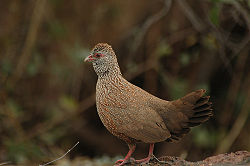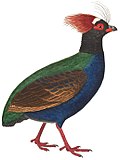Taxonomy
The genus Ptilopachus was introduced in 1837 by the English naturalist William Swainson to accommodate a single species, the stone partridge, which is therefore the type species. [2] [3] The genus name is from Ancient Greek ptilon meaning "feather" with pakhus meaning "thick" or "dense". [4]
As traditionally defined, only the stone partridge was included in this genus, but based on genetic evidence, it now also includes Nahan's partridge (formerly considered a francolin). The study also concludes that this genus is more closely related to the New World quails (Odontophoridae) and might be considered their only African representative. [5] [6] [7]
| Image | Genus | Common name | Distribution |
|---|
 | P. petrosusGmelin, 1789 | Stone partridge | Kenya and Ethiopia to Gambia |
 | P. nahani(Dubois, AJC, 1905) | Nahan's partridge | northeastern DR Congo and western Uganda |
|
This page is based on this
Wikipedia article Text is available under the
CC BY-SA 4.0 license; additional terms may apply.
Images, videos and audio are available under their respective licenses.






